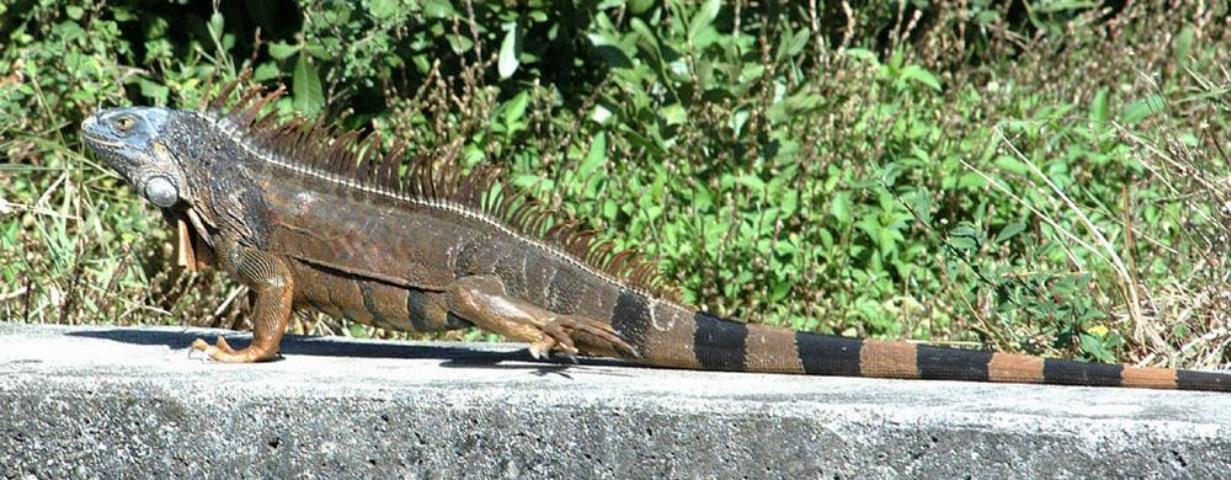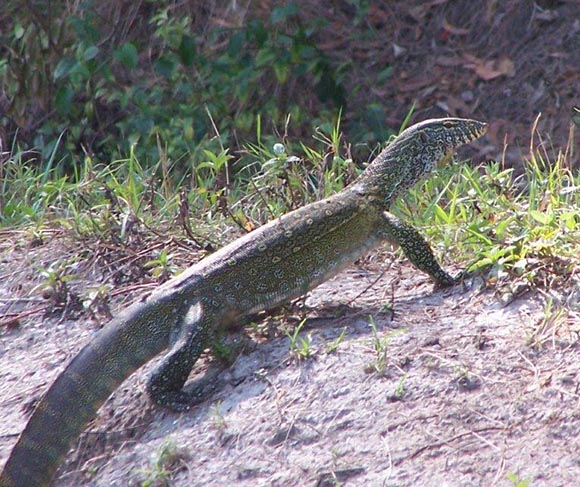Plants and animals that live outside of their native ranges as a result of human activity are known as nonnative species. Although not all nonnative species become invasive, those that do have the ability to harm ecology, economy, and human health. These nonnative invaders have caused an imbalance in Florida’s reptile populations. Read on to learn more about identifying the exotic lizards we have in central Florida.
Green Iguanas
There are many former pet iguanas that have either escaped or been released. These reptiles have established populations in both south and central Florida.
Green iguanas are large lizards that can grow to be 4-6 feet long. While young, green iguanas have a vibrant green color which tends to dull to a grayish green with age. Additionally, individuals may develop a reddish orange coloration during the breeding season. Male green iguanas can be identified by the larger spikes along their back.

Green iguanas are vegetarians and tend to feed on foliage, flowers, and fruit. They are commonly seen along seawalls and canal banks, eating landscaping plants, and resting in trees.
Although they do not compete with our native lizards, they do cause problems in other ways. For instance, their feeding often damages and destroys landscape plants and shrubs, flowers, and dooryard fruit (with the exception of citrus). The sight and smell of their waste are also often problematic and can transmit salmonella.

Furthermore, their habit of creating large burrows is a threat to our public infrastructure. According to a Florida Fish and Wildlife Conservation Commission, “Some green iguanas cause damage to infrastructure by digging burrows that erode and collapse sidewalks, foundations, seawalls, berms and canal banks.”
Nile Monitor

Nile monitors are large lizards that can grow to be over 5 feet long and weigh approximately 15 pounds. They tend to be light yellow to dark olive or brown in color and have a light yellow chevron pattern on their backs.
Nile monitors are semi-aquatic and can often be found basking in the sun or foraging for food along canal banks. Nile monitors are excellent swimmers. These reptiles have the ability to stay submerged under water for long periods of time. They are active during the day, and often retreat to their burrows or other refuges at night.
Nile monitors have a varied diet feeding on mammals, birds, reptiles, amphibians, fish, and eggs. Because of this, the Florida Fish and Wildlife Conservation Commission (FWC) has high concerns about their social, economic, and environmental impact.
Argentine Black & White Tegu

The Argentine black and white tegu is a large lizard that can grow up to four feet long. They are black and white in color with banding along their tails. Adolescent tegus have greenish heads. Tegus primarily spend their time on land. However, they are proficient swimmers and can remain underwater for long periods of time. Tegus are active during the day and burrow at night.
The Argentine black and white tegu’s diet primarily consists of fruits, eggs, insects, and small animals such as lizards and rodents. Dog and cat food attracts black and white tegus. Therefore, do not leave pet food outdoors.
The tegus have the potential to compete with and prey on Florida’s native wildlife and threatened species. They are very resilient creatures who can survive temperatures as low as 35 degrees and reproduce quickly, laying up to 35 eggs per year. Because of this, the FWC has high concerns about their environmental, economic, and social effects.
How Can I Help?
Report your sighting
Please report these species when you see them! This helps us understand their current population level and range.
To report sightings of nonnative species, visit the Early Detection and Distribution Mapping System’s (EDDMapS) webpage and follow these steps:
- Using the toolbar on the EDDMapS homepage, click “Report Sightings”.
- Select the location of the invasive species that you are reporting.
- Choose which type of species that you are reporting (plants, insects, diseases, or wildlife)
- Complete the report form and upload any images that you may have when prompted. Photos of the species in question are very important, to add credibility to your reports. These images will be verified for identification and, if needed, the identified species will be updated for accuracy by experts. You can also add any additional information that may be helpful at the bottom portion of the form.
- When you have completed the web form, click “submit report” at the bottom of the page.
You will need to create a FREE EDDMapS account when prompted in order to report your sightings. For additional instructions on how to report exotic species online, click here for a step-by-step guide. You may also report species by downloading EDDMapS’ app, “I’ve Got 1” from the App Store for IOS or Google Play store for Android.
Humanely remove the species from your property

From Florida Fish and Wildlife Conservation Commission: “The FWC encourages removal of green iguanas from private properties by landowners. Members of the public may also remove and kill iguanas from 22 FWC managed public lands without a license or permit under Executive Order 17-11. Captured iguanas cannot be relocated and released at other locations in Florida. Homeowners that trap iguanas on their property may be able to obtain euthanasia services from local exotic veterinarians, humane societies or animal control offices depending on the location and availability of services. If you are not capable of safely removing iguanas from your property, please seek assistance from a professional nuisance wildlife trapper.” (emphasis added by the blog author, not FWC)
According to Dealing with Iguanas in the South Florida Landscape, “The meat of adult iguanas and the eggs are eaten and considered a delicacy throughout their native range, especially during Easter week. As of 2004, the price of iguana meat was $14/pound in Maryland.” For meat that is to be consumed by humans, the recommended method of humane euthanasia is a carbon dioxide chamber. This method, while possible to do properly in a residential setting, is recommended to be performed by a licensed veterinarian or other local professional.
If you enjoyed this series and would like to read more about commonly confused plants and animals in Florida, you can find more here:
https://blogs.ifas.ufl.edu/global/tag/commonly-confused/
Sources:
- http://solutionsforyourlife.ufl.edu/hot_topics/lawn_and_garden/iguanas_landscape.shtml
- http://myfwc.com/wildlifehabitats/nonnatives/reptiles/green-iguana/
- http://myfwc.com/wildlifehabitats/nonnatives/reptiles/nile-monitor/
- http://myfwc.com/wildlifehabitats/nonnatives/reptiles/argentine-black-and-white-tegu/
- http://edis.ifas.ufl.edu/in528
- http://lee.ifas.ufl.edu/AgNatRes/Pubs/Dealing_with_Iguanas_in_the_Southwest_Florida_Landscape.pdf
Originally Published: Oct. 2017
Last Updated: Jul. 2020
Ms. Paxton Evans, Natural Resources Extension Program Intern, wrote this blog post under supervision of Natural Resources and Conservation Extension Agent, Mrs. Shannon Carnevale.
University of Florida IFAS Extension is committed to diversity of people, thought and opinion, to inclusiveness and to equal opportunity.
UF/IFAS Extension is an Equal Opportunity Institution.
 2
2

